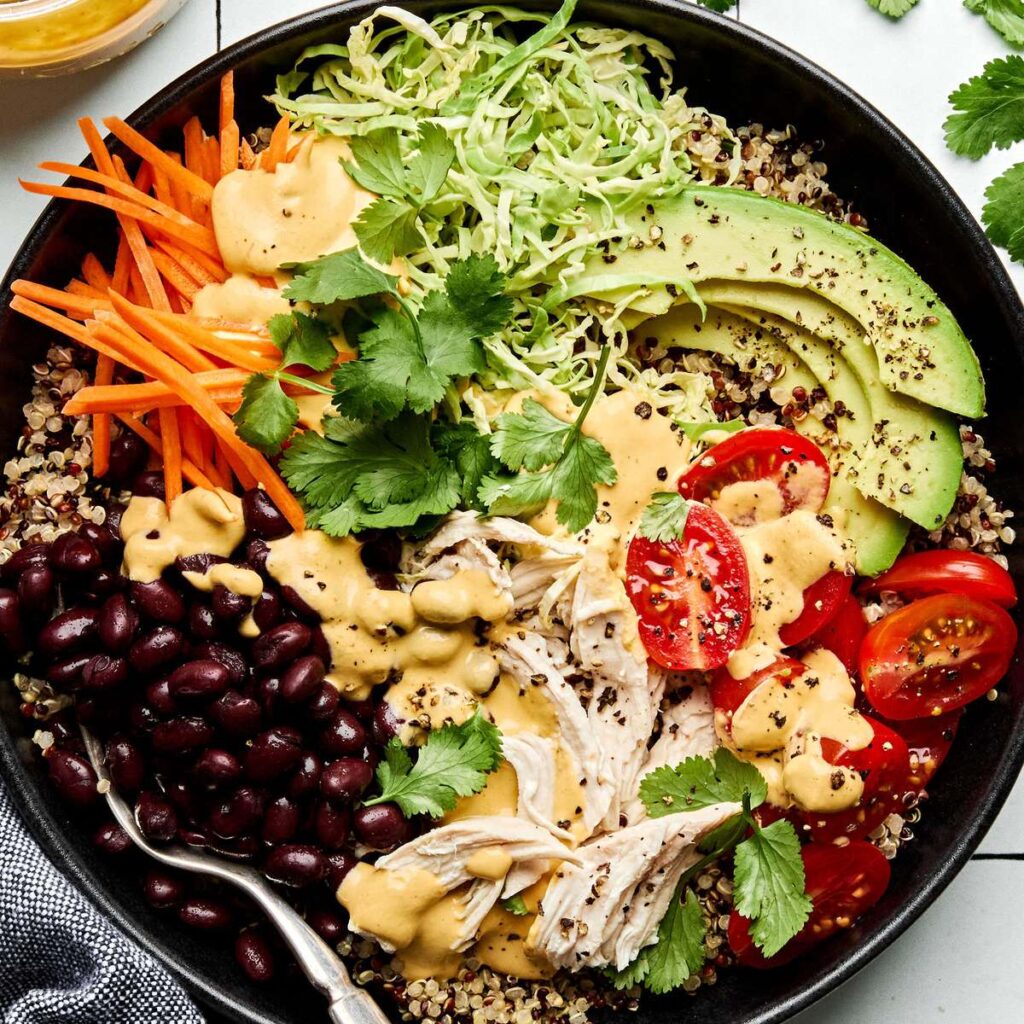Welcome to a TASTETROVE into low FODMAP eating, where digestive comfort meets delicious simplicity. If you’re managing irritable bowel syndrome (IBS) or similar gut sensitivities, our Low FODMAP Lemon Herb Chicken and Quinoa recipe is a game-changer. This dish combines tender, zesty chicken with nutrient-packed quinoa, all while adhering to low FODMAP guidelines to minimize bloating, gas, and discomfort.
In this in-depth article, we’ll explore the foundations of the low FODMAP diet, break down the key ingredients’ benefits, provide a step-by-step recipe, offer variations and meal prep strategies, and discuss long-term health perks. Whether you’re new to FODMAP restrictions or a seasoned follower, this meal proves that gut-friendly food can be exciting and satisfying.

For more low FODMAP inspiration, browse our internal low FODMAP recipe collection or dive into FODMAP basics on our blog. Let’s ease your symptoms one bite at a time!
Understanding the Low FODMAP Diet: A Quick Primer
The low FODMAP diet isn’t about cutting calories—it’s a targeted approach to identifying and managing food triggers for digestive woes. Developed by researchers at Monash University, FODMAP stands for Fermentable Oligosaccharides, Disaccharides, Monosaccharides, and Polyols—short-chain carbs that can ferment in the gut, drawing water and producing gas in sensitive individuals.
The Phases of the Diet
The diet unfolds in three stages:
- Elimination: For 2-6 weeks, avoid high FODMAP foods to reset your gut. Focus on low FODMAP options like our featured recipe.
- Reintroduction: Gradually test FODMAP groups (e.g., fructans, lactose) to pinpoint personal triggers.
- Personalization: Maintain a liberalized diet, avoiding only your specific sensitivities for long-term sustainability.
| Phase | Duration | Goal |
|---|---|---|
| Elimination | 2-6 weeks | Symptom relief by removing high FODMAPs |
| Reintroduction | 6-8 weeks | Identify triggers through challenges |
| Personalization | Ongoing | Customized, balanced eating plan |
This structured method can reduce IBS symptoms in up to 75% of people, including less bloating, pain, and irregular bowels. As Cleveland Clinic explains, it’s not a lifelong restriction but a tool for empowerment.
Common Challenges and Tips
Starting out? You might miss favorites like garlic or onions, but garlic-infused oils and herbs step in seamlessly. Hydrate well (aim for 8-10 glasses daily) and track symptoms with apps like Monash FODMAP. Work with a dietitian to avoid nutrient gaps—common in elimination phases.
Pro tip: Batch-cook low FODMAP staples like quinoa to save time. For external guidance, Johns Hopkins’ FODMAP overview is invaluable. With basics covered, let’s spotlight why chicken shines in this diet.
Why Chicken is a Low FODMAP Staple
Chicken is a versatile, protein-rich hero for low FODMAP dieters, offering flavor without the fermentable carbs that spell trouble. Naturally free of FODMAPs, it’s a safe bet during elimination and beyond.
Nutritional Profile of Chicken
A 3-ounce (85g) serving of grilled chicken breast provides:
- Calories: 140
- Protein: 26g
- Fat: 3g (mostly unsaturated)
- Carbs: 0g (net FODMAPs: negligible)
- Key Nutrients: Niacin (50% DV), vitamin B6 (30% DV), phosphorus (20% DV), selenium (40% DV).
This lean profile supports muscle repair and satiety without gut irritation. Monash University confirms plain chicken is low FODMAP, but watch for marinades with onion or garlic.
Health Benefits for Low FODMAP Followers
- Digestive Ease: Zero carbs mean no fermentation, reducing gas and bloating. Ideal for IBS, where protein helps stabilize blood sugar.
- Nutrient Boost: High in B vitamins for energy and selenium for immune support—crucial when restricting fruits/veggies initially.
- Weight Management: Protein promotes fullness, aiding those with IBS-related appetite fluctuations. Studies link adequate protein to better gut health outcomes.
- Versatility: Grill, bake, or stir-fry—chicken adapts. For low FODMAP, use herbs like thyme or rosemary instead of high-FODMAP spices.
Opt for skinless breasts to keep fats low, or thighs for juiciness. Explore our low FODMAP proteins guide internally, or Monash’s meat blog externally.
Quinoa: The Gut-Soothing Pseudo-Grain
Quinoa, a seed masquerading as a grain, is a low FODMAP favorite—gluten-free and easy on the tummy. One cup cooked is low FODMAP, providing bulk without excess fermentation.
Nutritional Breakdown of Quinoa
One cup (185g) cooked quinoa offers:
- Calories: 222
- Protein: 8g (complete, with all essential amino acids)
- Fat: 4g
- Net Carbs: 34g (but low FODMAP at 1 cup serving)
- Fiber: 5g
- Highlights: Magnesium (30% DV), iron (15% DV), folate (19% DV).
Its fiber aids gentle digestion, countering low FODMAP fiber dips.
Why Quinoa Excels on Low FODMAP
- Fiber Support: Soluble fiber promotes regular bowels without FODMAP overload, easing constipation common in IBS.
- Complete Protein: Rare for plants, it’s a boon for vegetarians on restricted diets. Spoonful app notes it fills fiber gaps.
- Anti-Inflammatory: Antioxidants like quercetin reduce gut inflammation, per NCBI research on quinoa.
- Blood Sugar Stability: Low glycemic index prevents spikes, beneficial for overlapping conditions like SIBO.

Rinse well to remove saponins for milder taste. For more, check our low FODMAP grains article.
Lemon and Herbs: Flavor Without FODMAP Fuss
Lemon adds zing, while herbs like thyme and rosemary bring depth—all low FODMAP approved.
Nutritional Insights
- Lemon (1 tbsp juice): 3 calories, vitamin C (10% DV), zero FODMAPs. Aids digestion via citric acid.
- Herbs (1 tsp dried thyme): Minimal calories, antioxidants, anti-microbial properties.
Benefits include gut-soothing effects; lemon balm calms spasms, per Gaia Herbs. Herbs enhance flavor safely, as Monash recommends.
The Ultimate Low FODMAP Lemon Herb Chicken and Quinoa Recipe
Inspired by FODMAP Friendly’s grilled version, this 30-minute meal serves 4 with ~5g FODMAPs per serving.
Ingredients
- 4 (6-oz) chicken breasts
- 1 cup quinoa, rinsed
- 2 cups low FODMAP broth
- Juice/zest of 1 lemon
- 2 tbsp olive oil
- 1 tsp each: thyme, rosemary (dried)
- Salt/pepper
- Fresh parsley (garnish)
Instructions
- Cook quinoa in broth for 15 mins; fluff.
- Marinate chicken in oil, lemon, herbs (30 mins).
- Grill chicken 6-7 mins/side (165°F).
- Serve over quinoa, drizzle juices.
| Nutrient | Per Serving |
|---|---|
| Calories | 350 |
| Protein | 35g |
| Carbs | 25g |
| Fiber | 3g |
Tips for Success
Use infused oils; store airtight. Adapted from Fun Without FODMAPs.
Variations and Substitutions
- Greek Twist: Add feta, cucumbers.
- Cajun: Spice with paprika.
- Subs: Tofu for vegan.
Meal Prep and Storage
Prep ahead: Cook quinoa Sunday, portion chicken. Fridge 3 days; freeze 2 months. Tips from Monash: Stock staples.
Fiber-Rich for Digestive Wellness and Cancer Prevention
Quinoa’s fiber content—up to 17% in some varieties—promotes digestive health by adding bulk to stools, preventing constipation, and nurturing gut bacteria. The Cleveland Clinic highlights that this fiber reduces colorectal cancer risk by speeding waste transit, minimizing exposure to carcinogens. A 2015 study linked high-fiber diets including quinoa to lower colon cancer incidence.
Soluble fiber forms a gel in the gut, slowing sugar absorption and stabilizing blood glucose. Insoluble fiber aids regularity. Fermentation studies show quinoa enhances iron bioavailability (5-8 times) via reduced phytates, benefiting those with anemia. Overall, quinoa’s prebiotic effects foster a healthy microbiome, linked to reduced inflammation and better immunity.
Antioxidant Powerhouse: Combating Oxidative Stress
Quinoa is loaded with antioxidants like quercetin (highest among Peruvian grains) and kaempferol, which neutralize free radicals, reducing cellular damage. Healthline reports these flavonoids have anti-inflammatory effects, potentially lowering chronic disease risk. A 2009 study found quinoa’s antioxidant activity (86%) surpasses other grains, aiding diabetes management by countering oxidative stress.
Phenolics (up to 202 mg/100g) scavenge radicals via Nrf2 pathways, while phytoecdysteroids (13.8-57 mg/100g) offer neuroprotective benefits. In gluten-free diets, quinoa boosts polyphenol intake, enhancing antioxidant capacity over rice-based products. Recent 2024 research confirms red quinoa polysaccharides’ anti-diabetic effects in mice via antioxidant mechanisms.
1. 20-Minute Low FODMAP Lemon Herb Chicken and Quinoa
Meal Prep Strategy (Serves 4, ~350 Cal/serving, 17g net carbs):
- Batch Prep Time: 20-25 min for 4 servings; double to 8 servings in ~30-35 min (5-7 min prep, 12-15 min cooking, +2-3 min for fresh herbs, per your query).
- Steps:
- Cook Quinoa in Bulk: Rinse 2 cups quinoa, simmer in 4 cups low FODMAP broth (20 min). Yields 8 servings.
Pairing Suggestions
Sides: Cucumber salad, carrots. Drinks: Herbal tea. For menus, see Healthline’s plan.
In-Depth Health Benefits
Combo aids microbiome, reduces inflammation. Long-term: Better quality of life, per Yale.
Frequently Asked Questions
Q: Is quinoa always low FODMAP?
Quinoa is considered low FODMAP, but it’s not a blanket rule for all servings or preparations. According to Monash University, a leading authority on the low FODMAP diet, one cup (150–185g) of cooked quinoa is classified as low FODMAP, making it safe for most people with IBS or gut sensitivities during the elimination phase. This portion contains negligible amounts of fermentable carbs (FODMAPs) like fructans, galacto-oligosaccharides, or polyols that could trigger bloating or discomfort.
Key Considerations
- Serving Size Matters: While 1 cup cooked (about 75g dry) is low FODMAP, larger portions may push into moderate FODMAP territory due to cumulative carbs. Stick to Monash-recommended servings to stay safe.
- Preparation is Key: Rinse quinoa thoroughly to remove saponins, which, while not FODMAPs, can irritate the gut in sensitive individuals. Avoid high FODMAP additives like garlic, onion, or certain sauces in recipes.
- Individual Tolerance: Even low FODMAP foods can cause issues for some. If you’re in the reintroduction phase or have unique sensitivities, monitor symptoms with a food diary.
For practical tips, check our low FODMAP grains guide. Externally, Monash’s FODMAP app or blog provides detailed portion guidance. Always consult a dietitian for personalized advice.
Q: Can I use fresh herbs?
you can absolutely use fresh herbs in the 20-Minute Low FODMAP Lemon Herb Chicken and Quinoa recipe, as well as in the 10 Irresistible Vegan Freezer Breakfast Burritos and 15-Minute Keto-Friendly Salmon and Asparagus, aligning with your interest in flavorful, gut-friendly, weight-loss-oriented, and plant-based meals. Since you’ve asked about vegetarian options, dairy-free adaptations, grilling, time investment, weight loss, plant-based costs, and now fresh herbs, I’ll focus on how fresh herbs enhance these recipes, their low FODMAP compatibility, cost and sourcing in Pakistan, and impact on prep time and nutrition. This response integrates with your prior queries, ensures dairy-free and plant-based options, and provides a concise yet comprehensive guide for October 2025, with internal/external links and visual inspiration.

This Lemon Herb Chicken and Quinoa embodies low FODMAP living—nourishing, tasty, simple. Embrace it for symptom relief and vitality. Explore more at our recipes. As VA notes, it’s about balance.
